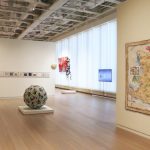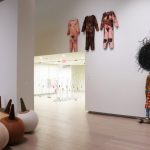Understanding contemporary Caribbean art outside of the Latin American framework
 By Gwen A. Unger From Hyper Allergic
By Gwen A. Unger From Hyper Allergic
Trying to subsume the Caribbean into a discourse of Latin America or America, curators argue, limits the ability to account for differences between islands.
Humberto Díaz, “Déja Vu” (2008), video still, 20:20Ed. 5/5 (image courtesy the artist)
Even with the rising influx of exhibitions focused on Latin American art, the Caribbean has yet to be given such expansive exposure. When contemporary Caribbean art is represented in exhibitions, more often than not, countries that do not qualify as Spanish-speaking are omitted. Where do these countries fit, if not in a Latin American model, or a North American model? Relational Undercurrents: Contemporary Art of the Caribbean Archipelago — now on view at the Wallach Art Gallery at Columbia University — attempts to answer this challenge.
Before making its way to the Wallach Art Gallery, Relational Undercurrents was first curated and organized as an exhibition for Pacific Standard Time: Los Angeles/Latin America at the Museum of Latin American Art in Long Beach (MOLAA), California. Pacific Standard Time (PST), an initiative started by the Getty Foundation, focuses on various cultural themes of Southern California, in collaboration with arts institutions of the region. The most recent iteration, Los Angeles/Latin America (or LA/LA) took place from September 2017 to January 2018, and focused on the dialogue between Latin American and Latino art and Los Angeles.
Relational Undercurrents is a survey of contemporary Caribbean art spanning several countries, including Haiti, the Dominican Republic, Cuba, Puerto Rico, Curacao, Aruba, St. Maarten, St. Martin, Martinique, Guadeloupe, Trinidad and Tobago, Jamaica, the Bahamas, Barbados, St. Vincent, and their diasporas. Featuring over 80 artists, the work consists of varying types of media such as installation, painting, photography, video, and performance. The curator, Tatiana Flores, is an associate professor of Art History and Latino and Caribbean Studies at Rutgers University, New Brunswick and a graduate of the Department of Art History and Archaeology, Columbia University.
In their catalogue essay, Flores and her collaborator Michelle A. Stephens outline the underlying assumptions, theories, and goals of the exhibition, in particular the idea of using the archipelago as an analytical framework. Whereas past exhibitions have focused on the diversity and hybridity inherent in the Caribbean, Flores explains that Relational Undercurrents is meant to highlight the connections among different experiences in the Caribbean, bringing together artists from variegated backgrounds and languages. The curators want to show the Caribbean as a shared experience, while not negating the diversity of the region, because, as Stephens and Flores write in their introductory essay to the catalogue, “the visual arts are uniquely equipped to bridge the region’s language and cultural divides.”
By using the archipelago as a framework for the exhibition, Flores and Stephens define the Caribbean from the perspective of its inhabitants rather than from the continent. Trying to subsume the Caribbean into a discourse of Latin America or America, they argue, limits the ability to account for differences in experience between islands.
Relational Undercurrents is separated thematically into four sections, though most works could easily fit into more than one. The first, “Conceptual Mappings,” includes works that imagine alternate mappings of the Caribbean and even further, the world, like Scherezade Garcia’s 2010 installation work “In My Floating World, Landscape of Paradise,” from her series Theories on Freedom. In this particular work, Garcia creates a map of the Caribbean using inner tubes, prints, plastic ties, and airline stickers from JFK, thus incorporating the Caribbean diaspora of New York into her map. The inner tubes evoke the journey from a Caribbean island over or through sea, and the connections that remain within the diaspora to the islands afterward.
Like “Conceptual Mappings,” the section “Landscape Ecologies” reimagines the Caribbean’s ocean and land. The works here challenge and subvert stereotypical romanticized ideas of the Caribbean as a paradise, rather considering it as a fragile ecosystem. In the age of climate change, rising sea levels, and extreme weather events, Caribbean islands are ever more in a precarious state of existence and survival, as evidenced by hurricane Maria and the havoc it wrought on Puerto Rico.
“Perpetual Horizons” demonstrates the “limit and potential” of the horizon as a motif and metaphor in Caribbean art — for example, in Cuba, where travel from the island is restricted, the horizon demonstrates the limit of where one is allowed to journey, while simultaneously evoking the possibility of life elsewhere, or the continuing potential of opening Cuba to the greater international community. Fermín Ceballos references the restricting aspect of the horizon in his piece “Aislamiento/Isolation,” a performance from August 2007, the documentation of which is displayed in Relational Undercurrents. In the performance, the artist swam out to a large rock formation off the coast of Santo Domingo in the early morning and built a structure that completely consumed him over hours. He stayed in the structure overnight, then hammered through from the inside at daylight and swam back to shore to the delight of onlookers on the coast. The isolation of the artist’s structure parallels the isolation many Caribbean islands experience from the international community (in terms of political power or the cost and feasibility of travel), yet Ceballos breaks down the walls of isolation and, by swimming back and forth, creates the connection of a “relational undercurrent.”
“Representational Acts,” the final section, gives Caribbean artists the space to represent themselves and make statements about their place in the world. There is plenty of commentary on the legacy of colonialism and assertions of their sovereignty, not only of their nations, but also as people, in particular people of color. Camille Chedda’s “Wholesale Degradables,” from 2014-15, a collection of various portraits of black men painted on degradable plastic bags, all in various states of decay, observes the marginal position of these men in society, as well as how the rest of the world perceives the Caribbean. Seemingly disposable, these images still exist, just as the real people they abstractly represent exist in time and space.
Another incredibly compelling work in this section, and in Relational Undercurrents as a whole, is Edgar Endress’s collaborative project with incarcerated Haitians (most of whom have never been informed of the grounds of their arrest, or also have been denied legal representation) and the Office of Human Rights in Haiti. Part social practice, part installation, “The Story of Institutions/La historia de las instituciones” displays small pieces of paper on which Haitian prisoners have written their stories and managed to deliver to the outer world via the hands of visitors, along with English and French translations (as most of the letters are in Creole) and rubber stamps. According to Endress, rubber stamps have a connotation of legitimacy in Haiti, especially in matters of bureaucracy and representation. In “The Story of Institutions,” Endress creates rubber stamps for each prisoner, giving them that sense of legitimacy in a system that otherwise views them as nonexistent and disposable.
Jeannette Ehlers,” Black Bullets” (2012), video still, 5:05 (image courtesy the artist)
Relational Undercurrents also has a component at the Sugar Hill Children’s Museum of Art & Storytelling. In a clever touch, each work there seems to have been hung at the level of a child’s height, besides those few pieces placed much higher, giving the viewer a feeling of looking at a sky. Miguel Luciano’s Amani Kites are displayed in the gallery this way, hung high from the ceiling, underneath a skylight at the museum, making the kites seem as if they are practically in flight, along with the children depicted on each one. Like Luciano’s kites, many of the works at Sugar Hill have a playful, performative element.
Unfortunately, the New York iteration of the exhibition does not have the same kind of dynamism it had at MOLAA. For example, whereas at MOLAA, Tony Capellan’s 2015 multi-media installation “Mar invadido” was wonderfully evocative, at the Wallach, it gets lost on the first floor behind ropes. Certain pieces are hard to identify, like one of the most compelling works in the exhibition: Jeannette Ehlers’s “Black Bullets” (2012), a video of figures walking down stairs but mirrored onto a landscape, seemingly disappearing into the abyss while ominous music plays in the background. Other works unfortunately lack enough space to express their overwhelming scale, or in some cases, their exacting intimacy, like Glenda León’s “Huella Cósmica/Cosmic Trace” (2008). While splitting the exhibition into two locations extends its visual reach, it unfortunately takes away from the overarching theme of unity within contemporary Caribbean art expressed in the catalogue. This exhibition is most striking when all the works are shown together, creating a cohesive, powerful statement.
Although certain spatial constraints in New York limit the potential of Relational Undercurrents one cannot help but be overwhelmed at the imagination and talent of fine artists in the Caribbean today. In comparison to past exhibitions of Caribbean art, Flores has managed to display something different and, with the help of Stephens, introduce a new way of thinking about the Caribbean to those who have only viewed it from a continental perspective. Through alternate mapping, Flores and Stephens focus on connections between islands in order to create a space for the Caribbean to wield its voice. Relational Undercurrents is a hopeful attempt to unite in a time where differences are increasingly maligned and marginalized. Perhaps the next exhibition for this team could be to illustrate the potential of the Pacific as a counterpoint to the Caribbean as an archipelagic structure, and what that might suggest for cultural creation for artists in those regions. The true standouts in this exhibition are the artworks themselves, each piece carefully selected and truly stunning.
Relational Undercurrents: Contemporary Art of the Caribbean Archipelago continues at the Wallach Art Gallery (Columbia University, 615 W 129th St, Morningside Heights, Manhattan) and Sugar Hill Children’s Museum of Art & Storytelling (898 St Nicholas Ave, Harlem, Manhattan) through September 23. Relational Undercurrents travels next to the Patricia and Philip Frost Art Museum at Florida International University (10975 SW 17th St, Miami,) in October 2018.
IMAGES:
Fermín Ceballos, “Isolation” (2005), photo of performance, Santo Domingo (photograph by Sayuri Guzmán, courtesy the artist)
Installation view of Relational Undercurrents: Contemporary Art of the Caribbean Archipelago at the Wallach Art Gallery, Columbia University (photo by Eddie José Bartolomei, courtesy the Wallach Art Gallery)
Humberto Díaz, “Déja Vu” (2008), video still, 20:20Ed. 5/5 (image courtesy the artist)
For more on this story go to: https://hyperallergic.com/459813/relational-undercurrents-contemporary-caribbean-art-wallach-art-gallery/









